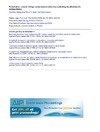Please use this identifier to cite or link to this item:
https://accedacris.ulpgc.es/jspui/handle/10553/41837
| DC Field | Value | Language |
|---|---|---|
| dc.contributor.author | Shibanuma, Toshihiko | en_US |
| dc.contributor.author | Maier, Stefan A. | en_US |
| dc.contributor.author | Albella, Pablo | en_US |
| dc.date.accessioned | 2018-09-04T14:52:18Z | - |
| dc.date.available | 2018-09-04T14:52:18Z | - |
| dc.date.issued | 2018 | en_US |
| dc.identifier.issn | 0003-6951 | en_US |
| dc.identifier.uri | https://accedacris.ulpgc.es/handle/10553/41837 | - |
| dc.description.abstract | Metasurfaces built of high refractive dielectric nanostructures could play a key role in controlling the electromagnetic wave propagation, due to their low energy losses and their ability to excite not only electric but also magnetic resonances. In this study, we theoretically and experimentally demonstrate that an array of high-index dielectric nanodimers can perform as tuneable metasurfaces that can be switched from a high transmitter to a high reflector, by just changing the linear polarization of excitation. The incident polarization alters the hybridization mode of the excited electric and magnetic dipoles in the dimer, and this leads to either spectral overlap or separation of the two dipoles. The hybridization of the electric and magnetic modes modifies the effective permittivity and permeability of the tuneable dielectric metasurface, exhibiting the high transmission and reflection that can be easily switched by simply changing the linear polarization. | en_US |
| dc.language | eng | en_US |
| dc.relation.ispartof | Applied physics letters | en_US |
| dc.source | Applied Physics Letters [ISSN 0003-6951], v. 112 (6), 063103 | en_US |
| dc.subject | 221201 Campos electromagnéticos | en_US |
| dc.subject | 2202 Electromagnetismo | en_US |
| dc.subject.other | Field Enhancement | |
| dc.subject.other | Resonances | |
| dc.subject.other | Plasmonics | |
| dc.title | Polarization control of high transmission/reflection switching by all-dielectric metasurfaces | en_US |
| dc.type | info:eu-repo/semantics/Article | es |
| dc.type | Article | es |
| dc.identifier.doi | 10.1063/1.5018783 | |
| dc.identifier.scopus | 85041706182 | |
| dc.identifier.isi | 000424703200033 | - |
| dc.contributor.authorscopusid | 26656961400 | |
| dc.contributor.authorscopusid | 7201635833 | |
| dc.contributor.authorscopusid | 14032984700 | |
| dc.identifier.issue | 6 | - |
| dc.relation.volume | 112 | - |
| dc.investigacion | Ingeniería y Arquitectura | en_US |
| dc.type2 | Artículo | en_US |
| dc.contributor.daisngid | 30402321 | |
| dc.contributor.daisngid | 28935 | |
| dc.contributor.daisngid | 924063 | |
| dc.contributor.wosstandard | WOS:Shibanuma, T | |
| dc.contributor.wosstandard | WOS:Maier, SA | |
| dc.contributor.wosstandard | WOS:Albella, P | |
| dc.date.coverdate | Febrero 2018 | |
| dc.identifier.ulpgc | Sí | es |
| dc.description.sjr | 1,331 | |
| dc.description.jcr | 3,521 | |
| dc.description.sjrq | Q1 | |
| dc.description.jcrq | Q1 | |
| dc.description.scie | SCIE | |
| item.fulltext | Con texto completo | - |
| item.grantfulltext | open | - |
| crisitem.author.orcid | 0000-0001-7531-7828 | - |
| crisitem.author.fullName | Albella Echave, Pablo | - |
| Appears in Collections: | Artículos | |
SCOPUSTM
Citations
36
checked on Jun 8, 2025
WEB OF SCIENCETM
Citations
36
checked on Jun 8, 2025
Page view(s)
42
checked on Sep 16, 2023
Download(s)
265
checked on Sep 16, 2023
Google ScholarTM
Check
Altmetric
Share
Export metadata
Items in accedaCRIS are protected by copyright, with all rights reserved, unless otherwise indicated.
